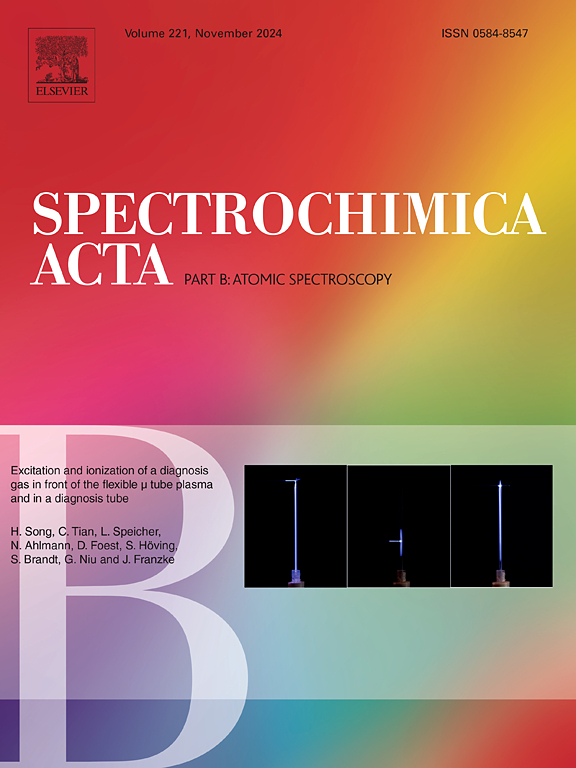固体材料EDXRF热值检测方法及影响机理研究
IF 3.8
2区 化学
Q1 SPECTROSCOPY
引用次数: 0
摘要
传统上,热值检测依赖于实验室方法,明显缺乏工业应用的快速技术。本文提出了利用EDXRF快速测定热值的方法,并以锌冶炼中浸出渣和焦炭混合物为例进行了验证。研究重点是利用x射线荧光检测复杂固体材料中的热值,突出了影响方法稳定性和准确性的关键因素。结果表明:(1)通过x射线荧光定量分析发热量,可以绘制出总光谱计数率、康普顿散射峰强度(Mo-Ka- c)和瑞利散射峰强度(Mo-Ka)之间的数值关系。(2)原料粒度、含水量、仪器参数等因素显著影响检测稳定性;湿度尤其重要。当含水量从干燥增加到30 wt%时,总计数与发热量的相关系数从0.8901降低到0.50342。(3) Mo-Ka-C强度与浸渣混合物热值相关的预测模型预测均方根误差(RMSEP)为0.59 MJ/kg,平均相对偏差(ARE)为4.24%,表明预测浸渣热值的精度有所提高。预测值的标准偏差(SD)为0.11 MJ/kg,重复性优于国家标准。本文章由计算机程序翻译,如有差异,请以英文原文为准。

Research on the calorific value detection method and influencing mechanism of solid materials via EDXRF
Traditionally, calorific value detection has relied on laboratory methods, with a notable lack of rapid techniques for industrial applications. This paper proposes using EDXRF for the quick determination of calorific values, demonstrated through a case study on leaching slag and coke mixtures from zinc smelting. The investigation focuses on detecting calorific values in complex solid materials via X-ray fluorescence, highlighting key factors that influence method stability and accuracy. The results show that (1) Quantitative analysis of calorific values through X-ray fluorescence allows plotting numerical relationships between total spectral count rate, Compton scattering peak intensity (Mo-Ka-C), and Rayleigh scattering peak intensity (Mo-Ka). (2) Factors such as raw material particle size, water content, and instrumental parameters significantly affect detection stability; moisture is particularly critical. As water content increases from dry to 30 wt%, the correlation coefficient between total count and calorific value decreases from 0.8901 to 0.50342. (3) A predictive model correlating Mo–Ka–C intensity with the calorific value of leaching slag mixtures predicts a root mean squared error (RMSEP) of 0.59 MJ/kg and an average relative deviation (ARE) of 4.24 %, indicating improved prediction accuracy for estimating leaching slag's calorific value. The standard deviation (SD) of predicted values was 0.11 MJ/kg, surpassing national standards for repeatability.
求助全文
通过发布文献求助,成功后即可免费获取论文全文。
去求助
来源期刊
CiteScore
6.10
自引率
12.10%
发文量
173
审稿时长
81 days
期刊介绍:
Spectrochimica Acta Part B: Atomic Spectroscopy, is intended for the rapid publication of both original work and reviews in the following fields:
Atomic Emission (AES), Atomic Absorption (AAS) and Atomic Fluorescence (AFS) spectroscopy;
Mass Spectrometry (MS) for inorganic analysis covering Spark Source (SS-MS), Inductively Coupled Plasma (ICP-MS), Glow Discharge (GD-MS), and Secondary Ion Mass Spectrometry (SIMS).
Laser induced atomic spectroscopy for inorganic analysis, including non-linear optical laser spectroscopy, covering Laser Enhanced Ionization (LEI), Laser Induced Fluorescence (LIF), Resonance Ionization Spectroscopy (RIS) and Resonance Ionization Mass Spectrometry (RIMS); Laser Induced Breakdown Spectroscopy (LIBS); Cavity Ringdown Spectroscopy (CRDS), Laser Ablation Inductively Coupled Plasma Atomic Emission Spectroscopy (LA-ICP-AES) and Laser Ablation Inductively Coupled Plasma Mass Spectrometry (LA-ICP-MS).
X-ray spectrometry, X-ray Optics and Microanalysis, including X-ray fluorescence spectrometry (XRF) and related techniques, in particular Total-reflection X-ray Fluorescence Spectrometry (TXRF), and Synchrotron Radiation-excited Total reflection XRF (SR-TXRF).
Manuscripts dealing with (i) fundamentals, (ii) methodology development, (iii)instrumentation, and (iv) applications, can be submitted for publication.

 求助内容:
求助内容: 应助结果提醒方式:
应助结果提醒方式:


